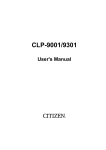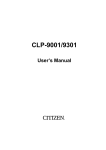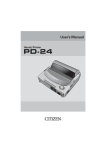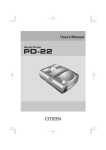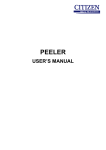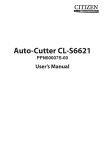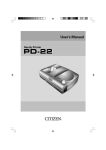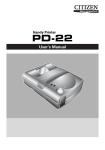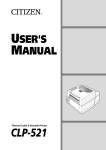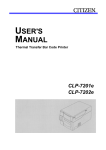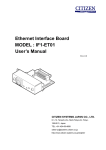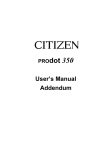Download Citizen CLP-8301 User Manual
Transcript
FCC COMPLIANCE STATEMENT FOR AMERICAN USERS This equipment has been tested and found to comply with the limits for a Class A digital device, pursuant to Part 15 of the FCC Rules. These limits are designed to provide reasonable protection against harmful interference when the equipment is operated in a commercial environment. This equipment generates, uses, and can radiate radio frequency energy and, if not installed and used in accordance with the instruction manual, may cause harmful interference to radio communications. Operation of this equipment in a residential area is likely to cause harmful interference in which case the user will be required to correct the interference at his own expense. COMPLIANCE STATEMENT FOR EUROPEAN USERS CE marking shows conformity to the following criteria and provisions: Low Voltage Directive (73/23/EEC)/EN60950 EMC Directive (89/336/EEC)/EN55022, EN55024, EN61000-3-2 & EN61000-3-3 CITIZEN is a registered trade mark of CITIZEN WATCH CO., LTD., Japan CITIZEN es una marca registrada de CITIZEN WATCH CO., LTD., Japón Company names and product names in this manual are trademarks or registered trademarks of relevant companies. Copyright 2006 by CITIZEN SYSTEMS JAPAN CO., LTD. i EMI COMPLIANCE STATEMENT FOR CANADIAN USERS This equipment generates and uses radio frequency energy and if not installed and used properly, that is, in strict accordance with the manufacturer's instructions, may cause interference to radio and television reception. This digital apparatus does not exceed the Class A limits for radio noise emissions from digital apparatus set out in the Radio Interference Regulations of the Canadian Department of Communications. This equipment is designed to provide reasonable protection against such interference in a residential installation. However, there is no guarantee that interference will not occur in a particular installation. If this equipment does cause interference to radio or television reception, which can be determined by turning the equipment off and on, the user is encouraged to try to correct the interference by one or more of the following measures: • Reorient or relocate the receiving antenna. • Increase the separation between the equipment and receiver. • Connect the equipment into an outlet on a circuit different from that to which the receiver is connected. • Consult the dealer or an experienced radio/TV technician for help. CAUTION: Use shielded cables to connect this device to computers. Any changes or modifications not expressly approved by the grantee of this device could void the user's authority to operate the equipment. ETAT DE CONFORMITE EMI A L'USAGE DES UTILISATEURS CANADIENS − ii − Important Safety Instructions 1. Read all of these instructions and save them for later reference. 2. Follow all warnings and instructions marked on the product. 3. Unplug this product from the wall outlet before cleaning. Do not use liquid or aerosol cleaners. Use a damp cloth for cleaning. 4. Do not use this product near water. 5. Do not place this product on an unstable cart, stand or table. The product may fall, causing serious damage to the product. 6. Slots and openings on the cabinet and the back or bottom are provided for ventilation. To ensure reliable operation of the product and to protect it from overheating, do not block or cover these openings. The openings should never be blocked by placing the product on a bed, sofa, rug or other similar surface. This product should never be placed near or over a radiator or heat register. This product should not be placed in a built-in installation unless proper ventilation is provided. 7. This product should be operated from the type of power source indicated on the marking label. If you are not sure of the type of power available, consult your dealer or local power company. 8. This product is equipped with a three-pronged plug, a plug having a third (grounding) pin. This plug will only fit into a grounding-type power outlet. This is a safety feature. If you are unable to insert the plug into the outlet, contact your electrician to replace your obsolete outlet. Do not defeat the safety purpose of the grounding-type plug. 9. Do not allow anything to rest on the power cord. Do not locate this product where the cord will be walked on. 10. If an extension cord is used with this product, make sure that the total of the ampere ratings on the products plugged into the extension cord do not exceed the extension cord ampere rating. Also, make sure that the total of all products plugged into the wall outlet does not exceed 15 amperes for 120V outlet and 7.5 amperes for 220−240V outlet. 11. Never push objects of any kind into this product through cabinet slots as they may touch dangerous voltage points or short out parts that could result in a risk of fire or electric shock. Never spill liquid of any kind on the product. 12. Except as explained elsewhere in this manual, don't attempt to service this product yourself. Opening and removing those covers that are marked "Do Not Remove" may expose you to dangerous voltage points or other risks. Refer all servicing on those compartments to service personnel. 13. The mains plug on this equipment must be used to disconnect mains power. Please ensure that the socket outlet is installed near the equipment and shall be easily accessible. 14. Unplug this product from the wall outlet and refer servicing to qualified service personnel under the following conditions: A. When the power cord or plug is damaged or frayed. B. If liquid has been spilled into the product. C. If the product has been exposed to rain or water. D. If the product does not operate normally when the operating instructions are followed. Adjust only those controls that are covered by the operating instructions since improper adjustment of other controls may result in damage and will often require extensive work by a qualified technician to restore the product to normal operation. E. If the product has been dropped or the cabinet has been damaged. F. If the product exhibits a distinct change in performance, indicating a need for service. − iii − Notice 1. Before use, be sure to read this manual. And keep it handy for reference when needed. 2. The contents of this manual may change without prior notice. 3. Reproduction, transfer, or transmission of the contents of this manual without prior consent is strictly prohibited. 4. We are not liable for any damage resulting from the use of the information contained herein, regardless of errors, omissions, or misprints. 5. We are not liable for any problems resulting from the use of optional products and consumable supplies other than the designated products contained herein. 6. Do not handle, disassemble or repair the parts other than those specified in this manual. 7. We are not liable for any damage caused by user's erroneous use of the printer and inadequate environment. 8. Data residing in the printer is temporary. Therefore, all data will be lost if power is lost. We are not liable for any damage or loss of profits caused by data loss due to failures, repairs, inspections, etc. 9. Please contact us if there are any mistakes or ambiguities within this manual. 10. If there are missing or incorrectly collated pages in this manual, contact us to obtain a new manual. − iv − Introduction Thank you for purchasing a Citizen CLP series barcode label printer. This manual is designed to help you quickly understand the basic operations of this printer. Features This printer accurately prints clear bar codes and various character fonts on media such as labels and tags at high speeds. Both direct thermal and thermal transfer printing is possible. • Wide media, yet small installation space Wide media up to 9" (228.6 mm) can be used in this printer, and yet only a small installation space is needed, thanks to an innovative interior and exterior design. • Easy operation control panel Printing operations such as printer setup, print position and interface configuration can be performed with the six keys on the control panel. Even an untrained operator can easily operate this printer by following the instructions on the LCD (Display). • Easy access to media and ribbon The wide-opening printhead allows for easy access to the media and ribbon so loading is quick and easy. • Minimum maintenance The printhead, platen, tear bar etc are thoughtfully designed to facilitate easy maintenance. The consumable mechanical items can be easily exchanged in minutes. • Interfacing to a computer The printer is equipped with the RS-232C serial and parallel interfaces as standard. Other interfaces such as USB, Ethernet and IEEE1284ECP are also optionally available. −v− Table of Contents FCC Compliance Statement for American Users.............................. i CE Declaration for European Users.................................................. i EMI Compliance Statement for Canadian Users .............................. ii Important Safety Instructions ............................................................ iii Notice ................................................................................................ iv Trademark Acknowledgement........................................................... iv Introduction........................................................................................ v Features ............................................................................................ v Table of Contents .............................................................................. vi Chapter 1 Unpacking .................................................................... 1 1.1 Printer accessories ................................................................. 2 Chapter 2 Safety Precautions ...................................................... 3 z Safety signs ............................................................................ 3 z Installation precautions ........................................................... 8 Chapter 3 Names and Functions of Printer Parts ...................... 9 3.1 Printer main body.................................................................... 9 3.2 Control panel .......................................................................... 12 Chapter 4 Media (Paper) and Ribbon .......................................... 15 4.1 Types of media ....................................................................... 15 4.2 Media size............................................................................... 18 4.3 Loading media (paper)............................................................ 19 4.4 Loading the ribbon .................................................................. 23 Ribbon tension adjustments ................................................... 27 Ribbon winding torque adjustments ....................................... 27 4.5 Printhead adjustments ............................................................ 28 Guide to media thickness ranges ........................................... 28 4.6 Media sensor adjustments...................................................... 29 Positioning the sensor ............................................................ 29 Selecting Media Sensor and AutoCal Mode........................... 30 4.7 Avoiding wrinkling of the ribbon .............................................. 31 Removing slack on winding side of ribbon (in front of printhead) .............................................................. 31 Removing slack on feeding side of ribbon (behind printhead) .................................................................. 32 − vi − Chapter 5 Power ON and Using the Control Panel ....................33 5.1 Connecting to a power outlet ..................................................33 5.2 Turning the printer ON.............................................................34 5.3 Ready Mode and Menu Mode.................................................35 5.4 Navigating the Menu System ..................................................36 5.5 Changing Menu Values ...........................................................37 5.6 Permanently Saving Printer Settings ......................................38 5.7 Producing a Test or Configuration Print ..................................39 5.8 Turning the printer OFF...........................................................40 Chapter 6 Configuring Your Printer Using the Menus ...............41 6.1 The Group Menu .....................................................................41 6.2 Page Setup Menu ...................................................................42 6.3 System Setup Menu................................................................43 6.4 After Print Menu ......................................................................45 6.5 Interface Setup Menu..............................................................46 6.6 Permanently Saving Settings Menu........................................47 6.7 Test Mode Menu......................................................................47 6.8 Menu Mode Description ..........................................................48 Chapter 7 Troubleshooting ...........................................................53 7.1 Items to check in case of trouble ............................................53 7.2 Error messages and corrective actions ..................................55 Chapter 8 Maintenance .................................................................57 8.1 Printer care..............................................................................57 8.2 Cleaning method .....................................................................58 Chapter 9 Specifications...............................................................59 9.1 General specifications.............................................................59 9.2 Interfaces.................................................................................60 9.3 PCMCIA Memory Card (factory-installed option) ....................63 9.4 Print width................................................................................64 9.5 Movable sensors .....................................................................65 9.6 Environmental requirements ...................................................66 − vii − − viii − Chapter 1 Unpacking Chapter 1 Unpacking First open the carton and take out the top foam damper, then lift the printer main body out of the carton, holding the bottom of the printer firmly. Also keep the carton and packing materials as the printer must be packed with those materials for future shipment. CAUTION • When taking the printer out of the carton, prepare ample space to set the printer down. To ensure safety, no fewer than two persons should lift the printer main body at this time. • Do not hold the foam damper when lifting the printer main body. −1− Chapter 1 Unpacking 1.1 Printer accessories First, you should check that all of the following accessories are put in the carton. If any are missing, please contact your supplier. • Power cord 1 piece • Ribbon takeup core 1 piece • Media holder shaft 1 piece • Media holder disks 2 pieces • Label media 1 piece • Ribbon 1 piece • Thermal head cleaner 1 piece • Ribbon mandrels 2 pieces • User's manual 1 copy −2− Chapter 2 Safety Precautions Chapter 2 Safety Precautions This chapter describes safety precautions when using the printer. Please read and understand the precautions in this chapter before using the printer. z Safety signs The various safety signs included in this manual and pasted on the printer are intended to inform you of the correct and safe handling of this printer and protect against personal injury and property damage. Please familiarize yourselves with the following safety signs and their meanings. −3− Chapter 2 Safety Precautions −4− Chapter 2 −5− Safety Precautions Chapter 2 Safety Precautions −6− Chapter 2 −7− Safety Precautions Chapter 2 Safety Precautions −8− Chapter 3 Names and Functions of Printer Parts Chapter 3 Names and Functions of Printer Parts This chapter describes the names and functions of each part of the printer. 3.1 Printer main body 1. Top cover The top cover is the upper part of the whole cabinet of the printer. To open lift evenly from both sides using the embossed patterns on the surface to help grip the cover and open it all the way until it stops at hinge stops. To close it, just return slowly to the original position. Top cover Embossed patterns on the surface (back side) Embossed patterns on the surface −9− Chapter 3 Names and Functions of Printer Parts 2. Inside the Printer 1 2 3 4 5 6 7 8 9 10 Tear bar Platen Control panel Transparent sensor (upper media sensor) Transparent sensor guide Printhead Media guide roller Reflective sensor (lower media sensor) Interface box Top cover 11 12 13 14 15 16 17 18 19 20 − 10 − Media holder disk Media guide (on both sides) Media holder supporting plate Media holder shaft Media guide lock screw Printhead adjustment lever Transparent sensor guide release lever Printhead release lever Ribbon guide plate Ribbon mandrel holder Chapter 3 3. Rear and side of printer − 11 − Names and Functions of Printer Parts Chapter 3 Names and Functions of Printer Parts 3.2 Control panel The control panel consists of an LCD displaying two lines of eight characters, two LEDs and six control keys. Two functions are assigned to each key except the MODE key. z Indications LCD (Display) Shows the current printer status by a message on the display. POWER LED Lights up when the printer power is turned on. READY LED • Lights up when the printer is placed into the print ready state. When the PAUSE key is pressed, the READY LED goes out and "Pause" is shown on the LCD (Display). By pressing the PAUSE key again, the READY LED lights up. − 12 − Chapter 3 Names and Functions of Printer Parts z Control keys On the control panel legend, in Ready mode, the text written ABOVE each key shows the key's function. In Menu mode, the text written BELOW each key shows the key's function. MODE key When the MODE key is pressed, the printer is placed into the Ready mode. When the MODE key is pressed again, the printer is placed into the Menu mode. Each time the MODE key is pressed, the printer toggles between the Ready mode and Menu mode. (See P35) Key functions in the Ready mode STOP key • Shows "JobClear" on the LCD (Display) if data is stored in print buffer. • Completes printing midway through the print job or data processing and shows "JobClear Yes/No" on the LCD (Display). • Pressing STOP again changes the selection of "Yes/No" under the display of "Job Clear". • Places the printer into paused state if it is waiting to receive data from the host computer. FEED key • Feeds one sheet of label when this key is pressed after TOF (top-of-form) positioning has been performed. • Performs TOF (top-of-form) positioning if the printer is part way through a label or page. Note: Sometimes the media may be set at irregular position when it is being loaded or the power to the printer is turned on. If this occurs, press the FEED key to advance the media to the top of the next label or page. PAUSE key • Completes current page printing midway through the print job and places the printer into paused status. To resume printing, press the PAUSE key again. • Places the printer into paused state if it is waiting to receive data from the host computer. FUNCTION key This is a reserved key; no operation is performed. REPEAT key • Reprints one job of the last printed label each time this key is pressed if the last print data is stored in print buffer and is not printed yet. • Performs no operation if no print data is stored in print buffer or printer is in printing state. − 13 − Chapter 3 Names and Functions of Printer Parts MODE key Printer enters the Menu mode, and the '∗ Page Setup' menu is shown on the LCD (Display). Key functions in the Menu mode MENU key Selects the next Group Menu or Menu Item. (See P35-37) UP key • Selects the next Group Menu or Menu Item. (See P35-37) • Selects the next Value of the Menu Item. (See P35-37) DOWN key • Selects the previous Group Menu or Menu Item. (See P35-37) • Selects the previous Value of the Menu Item. (See P35-37) SELECT key • Enters the Menu Item from the Group Menu. (See P35-37) • Enters or exits the Value from the Menu Item. (See P35-37) • Executes current setting of the Value, for example, "Printing Sample" in Test mode. (See P39) EXIT key Return to the Menu Item or Group Menu. (See P35-37) MODE key Return to the Ready mode and the 'READY' is shown on the LCD (Display). (See P35, 36) − 14 − Chapter 4 Media (Paper) and Ribbon Chapter 4 Media (Paper) and Ribbon This chapter describes all of the types of media available for this printer and how to load the media and ribbon. Unless otherwise specified, the term 'media,' 'paper,' 'page,' 'labels,' or 'tags' is referring to any media that is being printed using the printer. 4.1 Types of media We recommend the use of CITIZEN media for optimal print quality. Types of media available for this printer: • Center-punched hole tag • Labels with inter-label gap • Black mark tag • Black mark label • Notched tag z Tag Media without adhesive material on the back are referred to as tags, which are often used by cutting pieces. The holes are usually arranged on the cut-off line. − 15 − Chapter 4 Media (Paper) and Ribbon ♦ Center-punched hole tag Holes (2.5mm diameter) are perforated lengthwise along the central line of the tag. ♦ Black mark tag Black marks are printed on the back of the tag at the center or on the right side in the direction of feed. ♦ Notched tag The cuts on the edge of this tag are deeper than the cuts on center-hole tag. − 16 − Chapter 4 Media (Paper) and Ribbon z Label Media with adhesive material on the back are referred to as labels. Labels are peeled off the liner piece by piece and stuck to a product or item. ♦ Labels with inter-label gap There are gaps between labels. ♦ Black mark label Black marks are printed on the back of the label line on the central line or right side in the direction of feed. − 17 − Chapter 4 Media (Paper) and Ribbon 4.2 Media size − 18 − Chapter 4 Media (Paper) and Ribbon 4.3 Loading media (paper) This printer is designed to align the center of the media (paper) with the center of the printhead, regardless of media (paper) width. Refer to the scale on the media guide plate (see P30) for aligning media (paper) or ribbon. And for reference, the center of the gear of the media guide drive mechanism, which is located on the bottom of the printer main body, is the center of the media (paper). Roll media 1. Put both media holder disks on the media holder shaft to make the media holder assembly. Adjust both disks according to the width of the roll media so that they are the same distance from the center of the media holder shaft and inside the media core. Media holder disk Media holder shaft 2. Insert the media holder assembly into the media core. Media holder assembly 3. Load the media into the printer by referring to the diagram and the following sequence: (1) Open the top cover all the way until it stops at hinges. (2) Unlock the printhead assembly by pushing the printhead release lever and raise it until it stops and stands upright. At the same time unlock the transparent sensor guide by pushing the transparent sensor guide release lever and raise it until it stops. − 19 − Chapter 4 Media (Paper) and Ribbon (3) Unlock the media guide lock screw and move both side media guides to their maximum outward position. Printhead assembly Transparent sensor guide Media guide (on both sides) Media guide lock screw Transparent sensor guide release lever Printhead release lever 4. Install the roll media as follows: (1) Place the media holder shaft onto the round notches on the media guides and media holder shaft supporting plates. (2) Move both media guides by using both hands so that they come into contact with the edges of the roll so that no clearance is left between media guide and media. (3) Lock the media guides with the media guide lock screw turned clockwise. Media holder shaft Media guide (on both sides) Round notch on media holder shaft supporting plate (on both sides) Media guide lock screw − 20 − Chapter 4 Media (Paper) and Ribbon 5. Route the roll media over the platen out to the front of the printer. 6. First lower the transparent sensor guide and push down gently to lock. Then lower the printhead assembly fully and push down firmly on the top edge by the ribbon holders to lock in place. Printhead assembly Transparent sensor guide Path of outward-wound roll media Path of inward-wound roll media Note: For media sensor adjustments, see P29. For loading ribbon, see P23. − 21 − Chapter 4 Media (Paper) and Ribbon 7. The roll media is now loaded. Lastly close the top cover. Fanfold media 1. Remove ribbon holder disks (two) from the ribbon holder assembly. Place the media holder shaft onto the round notches on the media guides and media holder shaft supporting plates on both sides. 2. Place the fanfold media on firm, level surface in the back of the printer and route it through the opening between top and lower bottom covers on the back of the printer, over the media holder shaft and platen out to the top of the printer. Other loading procedures are same as for roll media (see P19-22). Media holder shaft − 22 − Chapter 4 Media (Paper) and Ribbon 4.4 Loading ribbon We recommend the use of CITIZEN Thermal Transfer Ribbon for optimal print quality. This printer is designed to align the center of the media (paper) with the center of the printhead, regardless of media width. Refer to the scale on the tear bar for aligning media (paper) or ribbon. And for reference, the center of the gear of the media guide drive mechanism, which is located on the bottom of the printer main body, is the center of the media. 1. To align the ribbon with the media (paper) being used, adjust the flange as follows: 1) First turn the Lock Nut on the ribbon mandrel counterclockwise, then turn the Ribbon Positioning Nut counterclockwise to move the Flange towards the center of the ribbon mandrel and to align it with the edge of the media being loaded. Ribbon Positioning Nut Flange Lock Nut Lock Nut Ribbon Positioning Nut 2) Referring to the scale on the tear bar, adjust the flange so that the ribbon is put in the center of the media. The value of half the ribbon width being used is the actual value on the scale. Scale 3) Check to see that the ribbon is positioned properly and fix the ribbon positioning nut by turning the lock nut clockwise. 4) Repeat the procedure for the second ribbon mandrel. − 23 − Chapter 4 Media (Paper) and Ribbon 2. Two ribbon mandrels are used for loading ribbon; one is inserted in the supply (unused) ribbon core and the other is inserted the ribbon takeup core. Wind the ribbon from the takeup mandrel until most wrinkles are no longer visible. NOTE The following procedure may help in loading the ribbon. First insert the mandrels into the supply and takeup ribbon cores, affix a small piece of adhesive tape at the end of the ribbon and then wind the ribbon around the takeup mandrel until the tape is hidden. Finally, install the ribbon by passing it through the lower side of the printhead assembly. CAUTION Be sure to wind the ribbon sufficiently over the adhesive clear tape fastened to the end of the ribbon. − 24 − Chapter 4 Media (Paper) and Ribbon 3. Perform the following sequence; open the top cover all the way until it stops at hinges, and unlock the printhead assembly by pushing the printhead release lever and raise it until it stops and stands upright. Printhead assembly Printhead release lever 4. Hold by both hands the ribbon with a length of about 300 mm (1 ft) unwound between mandrels; the left hand grips the ribbon supply mandrel and the right hand grips the takeup mandrel. Ribbon supply mandrel gripped by left hand Takeup mandrel gripped by right hand Location for ribbon mandrels when installed − 25 − Chapter 4 Media (Paper) and Ribbon 5. Temporarily winding the ribbon with a length of about 300 mm (1 ft) unwound between mandrels around the lower, bottom side of the printhead assembly, first fit both sockets of the ribbon takeup and supply mandrels, then snap into place both knobs of the ribbon takeup and supply mandrels. Knob of ribbon takeup mandrel Knob of ribbon supply mandrel Socket of ribbon supply mandrel Socket of ribbon takeup mandrel 6. Remove any slack and wrinkles by turning the knob of the ribbon takeup mandrel clockwise, making sure that the ribbon is wound evenly between two mandrels. 7. Lower the printhead assembly with ribbon and push down firmly to lock. The ribbon is now loaded. Lastly close the top cover. − 26 − Chapter 4 Media (Paper) and Ribbon Ribbon tension adjustments The ribbon tension should be adjusted as needed according to the media (paper) width to prevent ribbon from wrinkling. To increase tension torque, turn the ribbon supply mandrel (the deeper side viewed from the front of the printer) knob clockwise until the required number is obtained on the scale, while stopping the gear with a coin inserted in the slit on the ribbon mandrel support and held down. Generally, the wider the ribbon, the greater the ribbon tension required. Ribbon winding torque adjustments If there are smudges on the print, adjust the ribbon winding torque from the control panel. Full details of using the control panel are shown later in the manual: From the menu system, select "∗Page Setup" of the Group Menu. Choose "Ribbon Torque" from the list of menu items. The default setting is Torque 3 so select Torque 2 or 1 to see that there are no smudges on the printout. To save the settings permanently after power off (if required) use the "∗Save Settings" of the Group Menu. (See P47) − 27 − Chapter 4 Media (Paper) and Ribbon 4.5 Printhead adjustments Printhead adjustments should be made according to the type of media (paper), using the printhead adjustment lever located on the back of the printhead assembly. Generally, for media with moderate stiffness (labels), position the printhead adjustment lever to the middle of the range to put the printhead in middle position, and for media with greater stiffness (tags or card), lower the adjustment lever to the lower level to put the printhead in forward position. For media with little stiffness, raise the adjustment lever to the upper level to put the printhead in a rearward position. − 28 − Chapter 4 Media (Paper) and Ribbon 4.6 Media sensor adjustments The printer is equipped with the upper and lower media sensors that are moved separately. Both media sensors detect the presence of media and top of form of media except continuous roll media. The media should be positioned for the media sensors as described in the following table. Positioning the sensor To adjust the media sensor position, perform the following operation: 1. Open the top cover all the way until it stops at hinges, unlock the printhead assembly by pushing the printhead release lever and open it towards the left side of the printer all the way until it stops and stands upright and at the same time unlock the transparent sensor guide by pushing the release lever and open it towards the left side of the printer all the way until it stops. 2. When the media is a black mark tag, align the black mark with the lower sensor position mark 'R.' Then lower the transparent sensor guide fully to the end and push it to lock and route the media over the platen out to the front of the printer. − 29 − Chapter 4 Media (Paper) and Ribbon 3. When the media is a center-punched hole or notched tag, first align the hole or notch with the lower sensor position mark 'T.' At this point, read the value of the scale on the media guide plate pointing the 'T' mark. And set the lower sensor guide fully and push it down gently to lock. Then move the pointer of the upper sensor to the same scale position as the lower sensor position mark 'T.' 4. The media sensor adjustments are now completed. Lastly return the printhead assembly and top cover to their original position. Note: You can see the level of the signal being produced by the media sensors using the "Sensor Monitor" from the "∗System Setup" menu. (See P43, 48) With the Sensor Monitor on the LCD screen, you can manually adjust the position of the media sensors after opening the printhead. This will aid in obtaining more accurate alignment of the media sensors. Selecting Media Sensor and AutoCal Mode The media sensor and AutoCal Mode selection should be made before printing for the first time or after changing the media. This is performed from the control panel. (For full details, see Chapter 6.) From the menu system, select the "System Setup" of the Group Menu. Choose the "Media Sensor" from the list of menu items and select the sensor type to match the media used (see P43). From the same Group Menu "System Setup," choose the "AutoCal Mode" and select "Yes" when any media sensor has already been selected from the "Media Sensor" above (see P44). This allows the printer to detect most media without calibration. However, if the media is not detected properly, first check the sensing levels using the "Sensor Monitor," then select the optimum value from the "Sensor Level." For example, when the label with liner (or the tag with black marks) is used, place the liner and non-liner portions of the label (or the black mark and non-black mark portions of the tag) between the sensors and read the values of the sensing levels respectively from the "Sensor Monitor." The average value of the measured sensing levels should be selected for the sensor level. − 30 − Chapter 4 Media (Paper) and Ribbon 4.7 Avoiding wrinkling of the ribbon If the ribbon wrinkles, the ribbon tension on either side of the ribbon will not be even. Remove slack on the ribbon in the following order: Removing slack on winding side of ribbon (in front of printhead) 1. Open the top cover all the way until it stops at hinges and unlock the printhead assembly by pushing the printhead release lever and open it towards the left side of the printer all the way until it stops and stands upright. 2. Loosen ribbon guide plate thumbscrews on both ends of the ribbon guide plate. Do NOT remove them just loosen them one turn. Never loosen screws other than these. You should be able to make adjustments to the ribbon guide plate with the ribbon installed. However, it may be easier to detach mandrels form the ribbon mandrel holders. This will depend on the ribbon width being used. 3. Remove slack and wrinkles on both sides. • When they are found on the right side of the ribbon (viewed from the front of the printer), move the right end of the ribbon guide plate towards you, • And when they are found on the left side of the ribbon (viewed from the front of the printer), move the left end of the ribbon guide plate towards you the plate can turn on the center set screw as the rigid point of support. 4. Check to see that slack and wrinkles on the ribbon are removed completely, and lastly tighten the guide plate thumbscrews on both ends. − 31 − Chapter 4 Media (Paper) and Ribbon Removing slack on feeding side of ribbon (behind printhead) 1. Open the top cover all the way until it stops at hinges and unlock the printhead assembly by pushing the printhead release lever and open it towards the left side of the printer all the way until it stops and stands upright. 2. Loosen the thumbscrew with the ribbon guide shaft a little (but not completely) and move it vertically to remove slack and wrinkles on both sides. • When they are found on the right side of the ribbon (viewed from the front of the printer), lower the thumbscrew towards the value of 10 on the scale, • And when they are found on the left side of the ribbon (viewed from the front of the printer), raise the thumbscrew towards the value of 0 (zero) on the scale. 3. Check to see that slack and wrinkles on the ribbon are removed completely, and lastly tighten the thumbscrew. − 32 − Chapter 5 Power ON and Using the Control Panel Chapter 5 Power ON and Using the Control Panel After loading the media and ribbon, connect the power cord and turn your printer on. 5.1 Connecting to a power outlet First plug the power cord into the AC power input on the back of the printer, then plug the other end of the power cord into the AC power outlet. − 33 − Chapter 5 Power ON and Using the Control Panel 5.2 Turning the printer ON Turn ON the power switch. • Press "|" for ON. • Press "O" to turn off the printer. Once the power is turned ON, the following initial messages are displayed on the screen for about three seconds. − 34 − Chapter 5 Power ON and Using the Control Panel 5.3 Ready Mode and Menu Mode This section describes the operation flow of the Ready mode and Menu mode. This printer can be easily operated using the six keys on the control panel. − 35 − Chapter 5 Power ON and Using the Control Panel 5.4 Navigating the Menu System − 36 − Chapter 5 5.5 Changing Menu Values − 37 − Power ON and Using the Control Panel Chapter 5 Power ON and Using the Control Panel 5.6 Permanently Saving Printer Settings − 38 − Chapter 5 Power ON and Using the Control Panel 5.7 Producing a Test or Configuration Print − 39 − Chapter 5 Power ON and Using the Control Panel 5.8 Turning the printer OFF − 40 − Chapter 6 Configuring Your Printer Using the Menus Chapter 6 Configuring Your Printer Using the Menus This chapter explains all the possible menu options for configuring the barcode printer. Refer to Chapter 5 for information on the operation of the menus system and which keys perform which actions. 6.1 The Group Menu − 41 − Chapter 6 Configuring Your Printer Using the Menus 6.2 Page Setup Menu − 42 − Chapter 6 6.3 System Setup Menu − 43 − Configuring Your Printer Using the Menus Chapter 6 Configuring Your Printer Using the Menus − 44 − Chapter 6 6.4 After Print Menu − 45 − Configuring Your Printer Using the Menus Chapter 6 Configuring Your Printer Using the Menus 6.5 Interface Setup Menu − 46 − Chapter 6 Configuring Your Printer Using the Menus 6.6 Permanently Saving Settings Menu 6.7 Test Mode Menu The Test Mode Menu allows the printer to produce configuration prints for current settings, machine information such as distance counter and test samples. It also allows for head checks, resetting the non-volatile memory to factory default values and a hex dump mode. − 47 − Chapter 6 Configuring Your Printer Using the Menus 6.8 Menu Mode Description − 48 − Chapter 6 − 49 − Configuring Your Printer Using the Menus Chapter 6 Configuring Your Printer Using the Menus − 50 − Chapter 6 − 51 − Configuring Your Printer Using the Menus Chapter 6 Configuring Your Printer Using the Menus − 52 − Chapter 7 Troubleshooting Chapter 7 Troubleshooting When an error occurs, an error message is displayed on the LCD panel. This chapter describes corrective actions to be taken when error message is received or problems or difficulties are experienced. 7.1 Items to check in case of trouble − 53 − Chapter 7 Troubleshooting − 54 − Chapter 7 7.2 Error messages and corrective actions − 55 − Troubleshooting Chapter 7 Troubleshooting − 56 − Chapter 8 Maintenance Chapter 8 Maintenance Since this printer uses a thermal head and a carbon ink ribbon、thermal paper dust etc may adhere to the printhead or other related parts. In this case, printing errors or failure of the printhead may occur. If paper dust or ribbon material adheres to the printhead, irregular printer movements, paper jams or poor print quality may occur. Therefore, be sure to clean the printhead, platen and media path periodically. The amount of cleaning will depend on the volume of media being printed and the quality of the consumables and media used in the printer. Genuine Citizen consumables will be you the best performance. If a defect should occur under normal use, it will be repaired free of charge during the warranty period. However, the printhead, platen and pinch roller will be regarded as consumable supplies. 8.1 Printer care Observe the following when caring for the printer. • Use a cotton swab or soft cloth to clean each part of the printer. • Hard or square tools such as screwdrivers can scratch any part of the printer. Never clean the printhead with such tools. • Before cleaning, make sure that the power to the printer is turned OFF and the power cord is disconnected from the mains supply. − 57 − Chapter 8 Maintenance 8.2 Cleaning method − 58 − Chapter 9 Chapter 9 Specifications 9.1 General specifications − 59 − Specifications Chapter 9 Specifications 9.2 Interfaces 1 Serial interface Specifications Transfer method: Start stop synchronous dual communication system Signal level: RS-232C Baud rate: 2400, 4800, 9600, 14400, 19200, 38400, 57600, 115200 bps Data bits: 7 or 8 Start bits: 1 Stop bits: 1 or 2 Parity: Even, odd, or none Connector: D-SUB 25PIN 17LE-13250-27(D41)(DDK) or its equivalent XON/XOFF protocol XON code output requirements: • Communication is enabled after power is turned ON. • Residual capacity of the buffer is 1K bytes or more after sending XOFF code. • XOFF code is output due to error and printer returns to normal conditions. XOFF code output requirements: • Printer is in error. • Printer is in paused state. • Receive buffer has less than 128 bytes available. − 60 − Chapter 9 Specifications DTR protocol DTR signal "Ready (High)" level requirements: The following must be satisfied: • Printer is on line. • Receive buffer has more than 128 bytes available. Note: When receive buffer has less than 128 bytes available, DTR signal becomes "Busy (Low)" level and this "Busy (Low) level is kept until receive buffer has at least 1K bytes available. DTR signal "Busy (Low)" level requirements: The following must be satisfied: • Printer is in error. • Receive buffer has less than 128 bytes available. Pin assignment − 61 − Chapter 9 Specifications 2 Parallel interface − 62 − Chapter 9 9.3 PCMCIA Memory Card − 63 − Specifications Chapter 9 Specifications 9.4 Print width − 64 − Chapter 9 9.5 Movable sensors − 65 − Specifications Chapter 9 Specifications 9.6 Environmental requirements 1 2 Printer operating conditions for ensuring print quality Operating temperature: 5°C − 40°C Humidity: 25% − 85% RH (non-condensing) Printer storage conditions Storage temperature: -20°C − 60°C Humidity: 25% − 85% RH (non-condensing) (Printer should be stored in a condition that the printhead is up and paper and ribbon are removed.) − 66 − 363 Van Ness Way, Suite 404 Torrance, CA 90501. USA Tel: (310) 781-1460 Fax: (310) 781-9152 http://www.citizen-systems.com Mettinger Strasse 11 D-73728, Esslingen Germany Tel: +49 (0) 711 3906 420 Fax: +49 (0) 711 3906 405 http://www.citizen-europe.com Park House, 643-651 Staines Road Feltham, Middlesex, TW14 8PA United Kingdom Tel: +44 (0) 20 8893 1900 Fax: +44 (0) 20 8893 0080 6-1-12, Tanashi-cho, Nishi-Tokyo-shi Tokyo, 188-8511. Japan Tel: +81 (0) 42 468 4608 Fax: +81 (0) 42 468 4996 http://www.citizen-systems.co.jp JH74900-51F BT6013-1102 Printed in Japan














































































